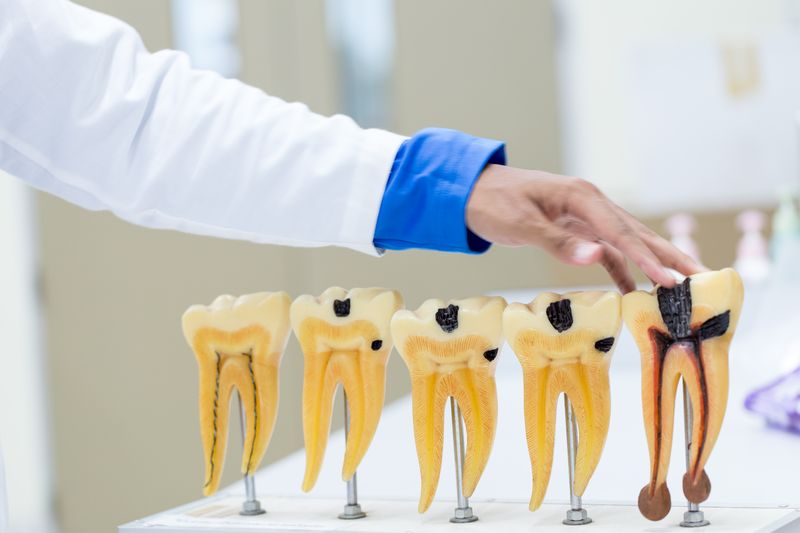Demystifying Cavities: What You Need to Know for a Healthy Smile

Things to Know About Cavities: Causes, Prevention, and Treatment
Introduction
Cavities, also known as dental caries or tooth decay, are one of the most prevalent dental issues worldwide. Despite their common occurrence, many people are still unaware of the essential facts surrounding cavities. This comprehensive blog aims to provide a thorough understanding of cavities, covering their causes, prevention strategies, and treatment options. By the end of this article, you will be well-equipped with knowledge to maintain excellent oral health and prevent cavities.
What Are Cavities?
Cavities are small holes or openings that form on the tooth surface due to the decay of dental tissues. They occur when bacteria in the mouth produce acids that attack the enamel—the hard outer layer of the tooth—resulting in demineralization and eventual tooth decay. If left untreated, cavities can progress deeper into the tooth, affecting the dentin and potentially leading to severe dental problems.
Causes of Cavities
Understanding the causes of cavities is crucial for preventing their occurrence. This section will delve into the primary factors that contribute to cavity formation:
Poor Oral Hygiene: Inadequate brushing, flossing, and lack of regular dental check-ups can lead to plaque buildup, creating an environment conducive to cavities.
Dietary Habits: Excessive consumption of sugary and acidic foods and beverages provides nourishment to cavity-causing bacteria, accelerating tooth decay.
Bacterial Activity: Streptococcus mutans and other harmful bacteria in the mouth produce acids that erode tooth enamel and cause cavities.
Dry Mouth: Reduced saliva flow due to medications or medical conditions can increase the risk of cavities as saliva helps neutralize acids and remineralize teeth.
Signs and Symptoms
Recognizing the signs of cavities is essential for timely intervention. This section will discuss common symptoms such as tooth sensitivity, visible pits or holes on teeth, toothache, and pain while chewing.
Signs and symptoms of cavities, also known as dental caries or tooth decay, can vary depending on the severity and location of the decay. In the early stages, cavities may not cause any noticeable symptoms, making regular dental check-ups essential for early detection. However, as cavities progress, common signs include tooth sensitivity, especially to hot, cold, or sweet stimuli. Discoloration or visible pits and holes on the tooth’s surface can also be indicative of decay. When the decay reaches deeper layers of the tooth, a persistent, dull ache or throbbing pain may arise, particularly during eating or drinking. As the cavity advances further into the tooth’s pulp, the pain can become intense and sharp, sometimes even leading to spontaneous, unprovoked toothaches. In severe cases, the pain may radiate to the surrounding areas of the face and jaw, causing further discomfort. It is crucial not to ignore dental pain, as early detection and treatment of cavities can prevent further damage and potential complications. If you experience any of these symptoms, seeking prompt dental evaluation and care is essential to alleviate pain and preserve your oral health. Prompt recognition of these signs and symptoms is vital to prevent further damage and seek appropriate dental care.
Prevention
Prevention is the key to maintaining good oral health and avoiding cavities. This section will explore effective preventive measures, including:
Proper Oral Hygiene: Brushing with fluoride toothpaste and flossing daily can remove plaque and protect teeth from decay.
Balanced Diet: Reducing sugar intake, avoiding sticky snacks, and incorporating tooth-friendly foods can help prevent cavity formation.
Fluoride Treatment: Understanding the benefits of fluoride in strengthening tooth enamel and its role in preventing cavities.
Dental Sealants: Exploring the use of dental sealants to protect vulnerable teeth, particularly in children.
Regular Dental Check-ups: Emphasizing the importance of routine 6 monthly dental visits for early detection and preventive care.
Treatment Options

This section will discuss various treatment options for cavities, depending on their severity:
Fillings
Fillings are a common and effective dental treatment used to restore teeth affected by cavities or dental caries. When a dentist identifies a cavity, they will typically recommend a filling to prevent further decay and restore the tooth’s structure and function. The filling process involves the following steps:
Numbing the Area: Before the procedure begins, the dentist may administer a local anesthetic to numb the area around the affected tooth, ensuring a pain-free experience during the filling placement.
Removal of Decay: The dentist will use a dental drill to remove the decayed portion of the tooth, creating a clean and cavity-free surface.
Preparation of the Cavity: The cavity is shaped and cleaned to create space for the filling material.
Filling Placement: Composite resin is placed into the prepared cavity and shaped to match the natural contours of the tooth.
Bonding and Curing:Composite resin is bonded to the tooth using a special adhesive. The filling is then hardened and set in place with a curing light.
Final Adjustments: The dentist will check the filling’s fit and make any necessary adjustments to ensure a comfortable bite and natural appearance.
Fillings effectively seal off the cavity, preventing bacteria from re-entering the tooth and halting the progression of decay. They restore the tooth’s strength and functionality, allowing patients to chew and speak without discomfort. Regular dental check-ups are essential to monitor the condition of fillings and ensure their longevity. With proper oral care and maintenance, dental fillings can provide lasting protection for restored teeth.
Root Canal Therapy
Understanding the procedure and its importance in saving severely decayed teeth. Root canal treatment, also known as endodontic therapy, is a dental procedure performed to save a severely damaged or infected tooth. It is necessary when the tooth’s pulp, which contains nerves, blood vessels, and connective tissues, becomes infected due to deep decay, repeated dental procedures, cracks, or trauma. During the treatment, the dentist first numbs the area using a local anesthetic to ensure the patient’s comfort. Then, an opening is made in the tooth to access the infected pulp, which is carefully removed. The interior of the root canals is cleaned, shaped, and disinfected to remove any remaining bacteria. Once the canals are thoroughly cleaned, they are filled with a biocompatible material called gutta-percha, and the tooth is sealed with a dental filling or crown to restore its function and appearance.
Root canal treatment is crucial as it alleviates the pain and discomfort associated with a severely infected tooth while preventing the spread of infection to the surrounding tissues and other teeth. The procedure has a high success rate and enables patients to retain their natural teeth, avoiding the need for extraction and subsequent tooth replacement options like dental implants or bridges. With proper care and regular dental check-ups, a tooth that has undergone root canal treatment can last a lifetime, restoring the patient’s ability to chew, speak, and smile with confidence.
Overall, root canal treatment is a valuable and effective dental procedure that plays a significant role in preserving oral health and maintaining the natural dentition. Dentists may recommend this treatment when dealing with advanced tooth decay or infection, providing patients with a chance to save their teeth and enjoy a pain-free and functional smile.
Crowns
Crowns, also known as dental caps, are a reliable and versatile restorative solution for heavily damaged or filled teeth. When a tooth has extensive decay, fractures, or has undergone multiple fillings, its structural integrity may be compromised. In such cases, a crown can be placed over the damaged tooth to strengthen and protect it from further damage. Crowns are custom-made to match the shape, size, and color of the natural teeth, ensuring a seamless blend with the patient’s smile.
The procedure for placing a crown typically involves two visits to the dentist. During the first visit, the dentist prepares the damaged tooth by removing any decayed or weakened areas and reshaping it to accommodate the crown. A digital scan is taken of the prepared tooth and sent to a dental laboratory to create a custom-made crown. In the meantime, a temporary crown is placed over the tooth for protection. During the second visit, the temporary crown is removed, and the permanent crown is cemented onto the tooth using dental adhesive. Crowns not only provide structural support to heavily damaged teeth but also enhance their appearance, giving patients a natural and aesthetically pleasing smile. With proper care and maintenance, crowns can last for many years, effectively restoring functionality and confidence to individuals with compromised teeth.
Extraction
When cavities are left untreated, the decay can progress deeper into the tooth, affecting not only the enamel but also the dentin and pulp, which houses the nerves and blood vessels. As the decay advances, it weakens the tooth’s structural integrity, leading to increased sensitivity, pain, and discomfort. If the decay reaches a point where the tooth cannot be effectively restored through other means such as fillings or crowns, tooth extraction becomes the last resort to prevent further complications.
Tooth extraction due to untreated cavities can have several negative effects on oral health and overall well-being. Losing a tooth can impact one’s ability to chew properly, affecting their diet and nutrition. Additionally, a gap left by a missing tooth can lead to shifting of adjacent teeth, causing misalignment and bite issues. The loss of a visible tooth can also lead to self-consciousness and reduced confidence in one’s smile. To avoid such consequences, it is crucial to address cavities promptly through regular dental check-ups, early detection, and timely intervention with appropriate treatments. Good oral hygiene practices and a balanced diet can also play a significant role in preventing the development of cavities and preserving natural teeth.
Children and Cavities

Children are particularly susceptible to cavities due to their developing teeth and dietary habits. This section will focus on cavity prevention strategies for children, the role of fluoride in pediatric dentistry, and the importance of early dental visits.
The Impact of Cavities on Children
Cavities can have several adverse effects on children’s oral health, which can significantly impact their overall well-being:
Pain and Discomfort: Cavities can cause toothaches, sensitivity to temperature, and discomfort while eating, which can affect a child’s ability to enjoy their favourite foods and impact their daily activities.
Difficulty in Chewing and Eating: Severe cavities can lead to tooth damage, making it difficult for children to chew their food properly, leading to poor nutrition and potential growth issues.
Sleep Disruptions: Dental pain from cavities can disrupt a child’s sleep, leading to irritability and difficulty in concentrating during school hours.
Affecting Speech Development: Cavities in primary (baby) teeth can interfere with speech development, leading to pronunciation difficulties and social challenges for the child.
Emotional and Psychological Impact: Dental problems can lead to self-consciousness and low self-esteem in children, affecting their confidence and social interactions.
Factors Making Children Vulnerable to Cavities
Several factors make children more susceptible to cavities compared to adults:
Dietary Habits: Frequent consumption of sugary snacks, candies, and sugary beverages can promote the growth of cavity-causing bacteria in the mouth.
Oral Hygiene Practices: Children may not have established effective oral hygiene habits, leading to inadequate brushing and flossing, which can facilitate plaque buildup.
Lack of Fluoride Exposure: Insufficient exposure to fluoride, either from tap water or fluoride toothpaste, can weaken tooth enamel, making teeth more vulnerable to decay.
Sealing of Grooves and Pits: The deep grooves and pits in children’s newly erupted molars are more challenging to clean, making them more susceptible to cavity formation.
Infrequent Dental Check-ups: Irregular dental visits can result in delayed detection of cavities, allowing them to progress to more advanced stages.
Preventive Measures
Preventing cavities in children involves a proactive approach and the collaboration of parents, caregivers, and dental professionals. Some essential preventive measures include:
Balanced Diet: Encouraging a diet rich in fruits, vegetables, and dairy products while limiting sugary snacks and drinks can promote healthy teeth and gums.
Proper Oral Hygiene: Parents should assist and supervise young children while brushing and flossing to ensure effective plaque removal.
Fluoride Use: Using age-appropriate fluoride toothpaste and ensuring children have access to fluoridated water can strengthen tooth enamel and prevent cavities.
Dental Sealants: Dental sealants are thin, protective coatings applied to the chewing surfaces of molars to prevent cavities in hard-to-reach areas.
Regular Dental Check-ups: Scheduling regular dental visits allows for early detection of cavities and prompt treatment.
Conclusion
In conclusion, cavities are a prevalent dental issue that can be prevented and treated with proper knowledge and care. By understanding the causes, recognizing the signs, and implementing effective preventive measures, you can maintain excellent oral health and preserve your beautiful smile. Regular dental check-ups and a commitment to oral hygiene are the cornerstones of cavity prevention and overall dental well-being. Remember, knowledge is the best weapon against cavities, so share this information with others to spread awareness and promote better oral health for all.
